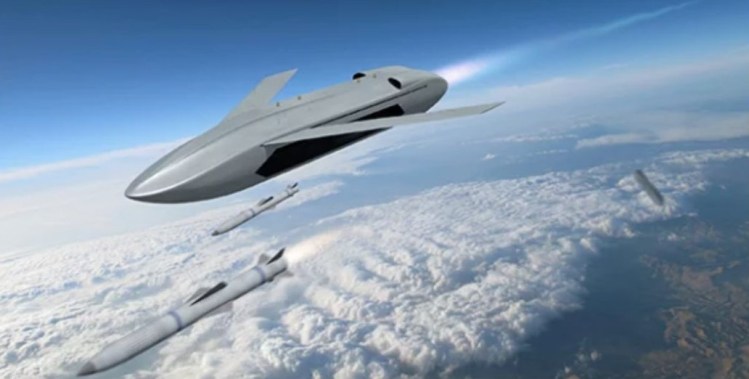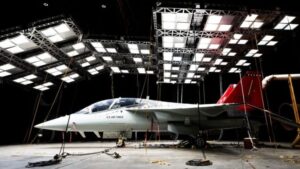The following article first appeared on Warrior Maven, a Military Content Group member website. The Pentagon envisions a potential scenario wherein large swarms of stealthy, armed air-launched attack drones might encircle an enemy area, destroy enemy air defenses, form a protective wall for manned aircraft or simply blanket an area with forward reconnaissance to identify targets in dangerous airspace. These kinds of Concepts of Operation continue to inform the Pentagon’s much discussed “Replicator” effort to acquire large numbers of coordinated drone fleets.
Early renderings of DARPA’s LongShot attack drone show what looks like a stealthy platform, and General Atomics has begun flight testing its LongShot Drone through its deal with DARPA to develop a stealthy armed air-to-air-combat capable drone. The concept is to launch the drone from a manned fighter and potentially even operate the drones in groups or swarms to blanket an area with protection or offensive firepower.
The DARPA effort, which naturally aims to bring ground-breaking attack possibilities to the Air Force, initially awarded developmental deals to Lockheed Martin, General Atomics, and Northrop Grumman. Now, the Pentagon has solely awarded a developmental deal to General Atomics. Early design work has been underway. Perhaps U.S. efforts with the armed, stealthy LongShot attack drone are well ahead of China’s GJ-11?

At first glance, China’s effort to deploy a stealthy armed attack drone may seem extremely cutting edge or novel, yet there is indeed a lot of precedent for this kind of platform. Stealthy drones and armed drones have now existed for many years, but a combined drone that is both armed and stealthy is much more rare.
However, the U.S. actually developed plans for an armed stealthy drone capable of taking off from the deck of an aircraft carrier.
The existence of the Chinese GJ-11 appears to mirror the configuration and possible mission scope of a former U.S. Navy program to deploy a first-of-its-kind armed, carrier-launched stealthy drone called UCLASS, for Unmanned Carrier Launched Airborne Surveillance and Strike program.
The aircraft, which evolved out of a multi-year developmental effort to build the X-47B demonstrator, was a pioneering breakthrough platform to build and operate a never-before-seen stealthy carrier attack drone.
The success of the program, which drew from the collective expertise of engineers, stealth experts and Navy scientists to build a drone able to manage the complex variables associated with landing on a carrier, gave rise to the UCLASS effort.
The following article first appeared on Warrior Maven, a Military Content Group member website. The Pentagon envisions a potential scenario wherein large swarms of stealthy, armed air-launched attack drones might encircle an enemy area, destroy enemy air defenses, form a protective wall for manned aircraft or simply blanket an area with forward reconnaissance to identify targets in dangerous airspace. These kinds of Concepts of Operation continue to inform the Pentagon’s much discussed “Replicator” effort to acquire large numbers of coordinated drone fleets.
Early renderings of DARPA’s LongShot attack drone show what looks like a stealthy platform, and General Atomics has begun flight testing its LongShot Drone through its deal with DARPA to develop a stealthy armed air-to-air-combat capable drone. The concept is to launch the drone from a manned fighter and potentially even operate the drones in groups or swarms to blanket an area with protection or offensive firepower.
The DARPA effort, which naturally aims to bring ground-breaking attack possibilities to the Air Force, initially awarded developmental deals to Lockheed Martin, General Atomics, and Northrop Grumman. Now, the Pentagon has solely awarded a developmental deal to General Atomics. Early design work has been underway. Perhaps U.S. efforts with the armed, stealthy LongShot attack drone are well ahead of China’s GJ-11?

At first glance, China’s effort to deploy a stealthy armed attack drone may seem extremely cutting edge or novel, yet there is indeed a lot of precedent for this kind of platform. Stealthy drones and armed drones have now existed for many years, but a combined drone that is both armed and stealthy is much more rare.
However, the U.S. actually developed plans for an armed stealthy drone capable of taking off from the deck of an aircraft carrier.
The existence of the Chinese GJ-11 appears to mirror the configuration and possible mission scope of a former U.S. Navy program to deploy a first-of-its-kind armed, carrier-launched stealthy drone called UCLASS, for Unmanned Carrier Launched Airborne Surveillance and Strike program.
The aircraft, which evolved out of a multi-year developmental effort to build the X-47B demonstrator, was a pioneering breakthrough platform to build and operate a never-before-seen stealthy carrier attack drone.
The success of the program, which drew from the collective expertise of engineers, stealth experts and Navy scientists to build a drone able to manage the complex variables associated with landing on a carrier, gave rise to the UCLASS effort.
The UCLASS drone ran into an interesting predicament, as it was intended, much like the new Chinese drone, to bring the dual-advantage of combining stealthy reconnaissance and air attack weapons capability into a single platform.
The program collided into a wall of debate, with some developers arguing that the aircraft needed to remain stealthy like the X-47B to defeat rival air defenses, yet others felt it needed to be larger, bulkier and therefore less stealthy to carry large fuel tanks in order to conduct longer-dwell missions without needing to return or refuel.
Added to this debate was the question as to whether the UCLASS should be an armed strike drone as well, something which seemed entirely feasible at the time. Engineering a stealthy drone able to take off and land from a carrier was itself a tremendous breakthrough for the Navy, and proposing to arm it certainly extended the curve even further. However, once the ability to autonomously land and take off on a carrier had been established by a sleek, stealthy-looking drone, the prospect of arming it did not seem impossible.
Ultimately, the platform never did quite seem to reconcile these positions or recover from this conceptual collision, and wound up evolving into what is now the MQ-25 Stingray aerial refueler drone. However, the X-47B program was extremely successful, historic and precedent setting, as a carrier-launched drone simply did not exist until the demonstrator emerged. Perhaps an X-47B-like armed carrier-launched stealth drone shall return? There are a lot of reasons why that might make sense.
Will China’s GJ-11 operate with a maritime take-off capability? That seems unlikely, however it would be a safe bet to assume that many at the Pentagon are not taking chances with this.



